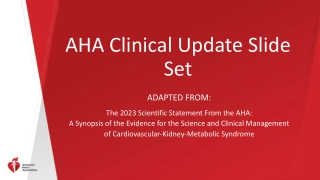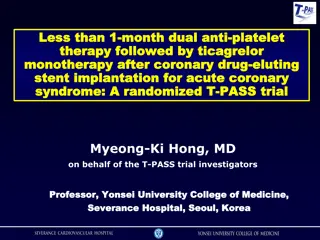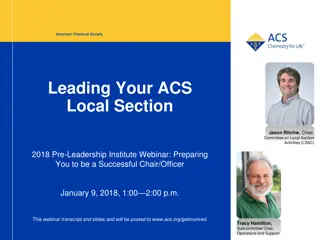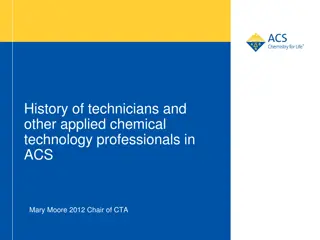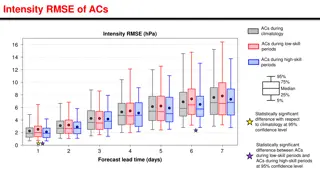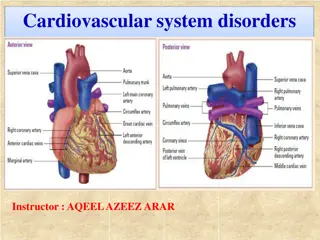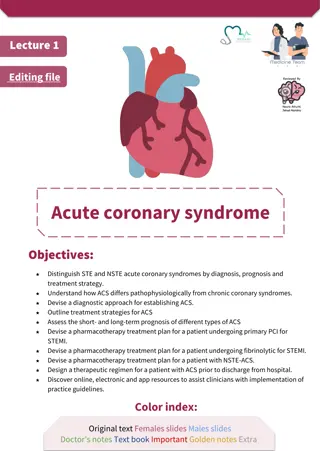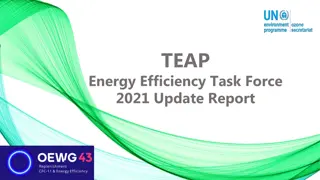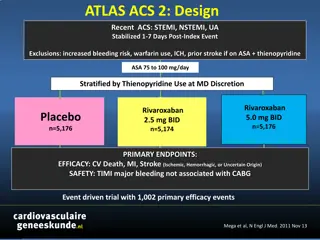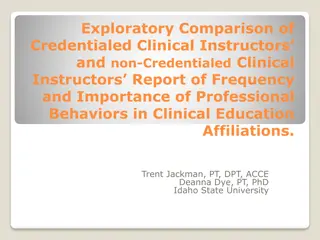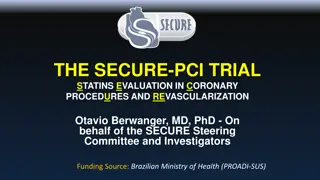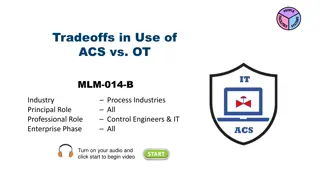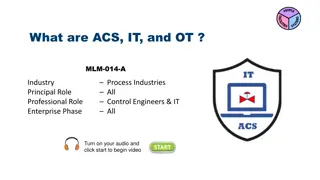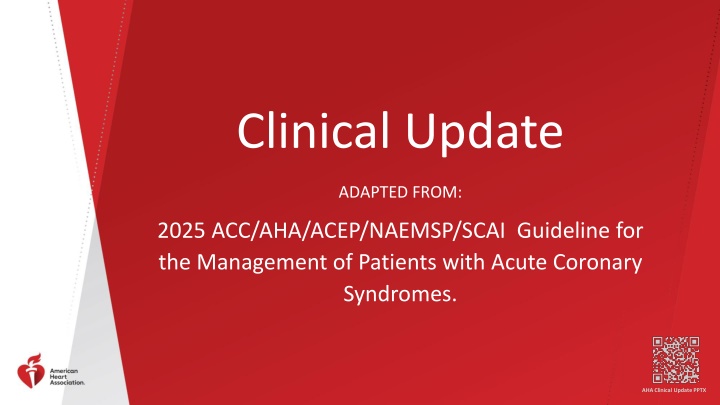
Guideline for Acute Coronary Syndromes Management Update
Stay informed with the latest updates from the 2025 ACC/AHA/ACEP/NAEMSP/SCAI Guideline for the Management of Patients with Acute Coronary Syndromes. Learn about the Class of Recommendation levels and Quality of Evidence to guide clinical strategies and interventions. Understand the strength of recommendations and levels of evidence, from strong Class 1 recommendations to weak Class 2b suggestions, and considerations for expert opinions. Stay ahead with evidence-based practices and make informed decisions for patient care.
Download Presentation

Please find below an Image/Link to download the presentation.
The content on the website is provided AS IS for your information and personal use only. It may not be sold, licensed, or shared on other websites without obtaining consent from the author. If you encounter any issues during the download, it is possible that the publisher has removed the file from their server.
You are allowed to download the files provided on this website for personal or commercial use, subject to the condition that they are used lawfully. All files are the property of their respective owners.
The content on the website is provided AS IS for your information and personal use only. It may not be sold, licensed, or shared on other websites without obtaining consent from the author.
E N D
Presentation Transcript
Clinical Update ADAPTED FROM: 2025 ACC/AHA/ACEP/NAEMSP/SCAI Guideline for the Management of Patients with Acute Coronary Syndromes. AHA Clinical Update PPTX
CLASS (STRENGTH) OF RECOMMENDATION LEVEL (QUALITY) OF EVIDENCE Table 1. Applying Class of Recommendation and Level of Evidence to Clinical Strategies, Interventions, Treatments, or Diagnostic Testing in Patient Care CLASS 1 (STRONG) Benefit >>> Risk LEVEL A High-quality evidence from more than 1 RCT Meta-analyses of high-quality RCTs One or more RCTs corroborated by high-quality registry studies Suggested phrases for writing recommendations: Is recommended Is indicated/useful/effective/beneficial Should be performed/administered/other Comparative-Effectiveness Phrases : Treatment/strategy A is recommended/indicated in preference to treatment B Treatment A should be chosen over treatment B LEVEL B-R (Randomized) Moderate-quality evidence from 1 or more RCTs Meta-analyses of moderate-quality RCTs LEVEL B-NR (Nonrandomized) CLASS 2a (MODERATE) Benefit >> Risk Moderate-quality evidence from 1 or more well-designed, well- executed nonrandomized studies, observational studies, or registry studies Meta-analyses of such studies Suggested phrases for writing recommendations: Is reasonable Can be useful/effective/beneficial Comparative-Effectiveness Phrases : Treatment/strategy A is probably recommended/indicated in preference to treatment B It is reasonable to choose treatment A over treatment B LEVEL C-LD (Limited Data) Randomized or nonrandomized observational or registry studies with limitations of design or execution Meta-analyses of such studies Physiological or mechanistic studies in human subjects CLASS 2b (Weak) Benefit Risk Suggested phrases for writing recommendations: May/might be reasonable May/might be considered Usefulness/effectiveness is unknown/unclear/uncertain or not well- established LEVEL C-EO (Expert Opinion) A recommendation with LOE C does not imply that the recommendation is weak. Many important clinical questions addressed in guidelines do not lend themselves to clinical trials. Although RCTs are unavailable, there may be a very clear clinical consensus that a particular test or therapy is useful or effective. COR and LOE are determined independently (any COR may be paired with any LOE). Consensus of expert opinion based on clinical experience. CLASS 3: No Benefit (MODERATE) Benefit = Risk * The outcome or result of the intervention should be specified (an improved clinical outcome or increased diagnostic accuracy or incremental prognostic information). Suggested phrases for writing recommendations: Is not recommended Is not indicated/useful/effective/beneficial Should not be performed/administered/other For comparative-effectiveness recommendation (COR 1 and 2a; LOE A and B only), studies that support the use of comparator verbs should involve direct comparisons of the treatments or strategies being evaluated. The method of assessing quality is evolving, including the application of standardized, widely-used, and preferably validated evidence grading tools; and for systematic reviews, the incorporation of an Evidence Review Committee. CLASS 3: Harm (STRONG) Risk > Benefit COR indicates Class of Recommendation; EO, expert opinion; LD, limited data; LOE, Level of Evidence; NR, nonrandomized; R, randomized; and RCT, randomized controlled trial. Suggested phrases for writing recommendations: Rao, S.V., et al. 2025 AHA/ACC/ACEP/NAEMSP/SCAI Guideline for Acute Coronary Syndromes. Circulation. Rao, S.V., et al. 2025 AHA/ACC/ACEP/NAEMSP/SCAI Guideline for Acute Coronary Syndromes. Circulation. Potentially harmful Causes harm Associated with excess morbidity/mortality Should not be performed/administered/other
Definition and Classifications of Acute Coronary Syndromes Biomarker Negative Unstable Angina Biomarker Positive NSTEMI Non-Occlusive Thrombus ST Depression or T Wave Inversion (May be electrically silent) Biomarker Positive STEMI (May be negative if drawn too early from symptom onset) Occlusive Thrombus ST Elevation Abbreviations: NSTEMI indicates non-ST-elevation myocardial infarction; and STEMI, ST-elevation myocardial infarction. Rao, S.V., et al. 2025 AHA/ACC/ACEP/NAEMSP/SCAI Guideline for Acute Coronary Syndromes. Circulation. 3
Pre-hospital Assessment and Management Considerations for Suspected ACS Suspected ACS Evaluation by Emergency Medical Services 12-Lead ECG Non-Diagnostic For STEMI STEMI Within 10 minutes of First Medical Contact Immediate transfer to PCI-capable hospital Transport to Local Emergency Department Goal of First Medical Contact to Device Time 90 minutes Further in-hospital assessment of confirmed or suspected ACS Serial ECGs To detect potential ischemic changes, especially if clinical suspicion for ACS remains high In patients with STEMI managed with primary PCI 7.5% each30 minute delay is associated with Abbreviations: ACS indicates acute coronary syndrome; ECG, electrocardiogram; STEMI, ST-elevation myocardial Infarction; and PCI, percutaneous coronary intervention. relative risk of 1-year death Rao, S.V., et al. 2025 AHA/ACC/ACEP/NAEMSP/SCAI Guideline for Acute Coronary Syndromes. Circulation. 4
Initial In-Hospital Assessment of Patients with Confirmed or Suspected ACS Focused History & Physical Examination Suspected ACS Obtain Cardiac Troponin (Class 1) ECG Within 10 Minutes (Class 1) No STEMI Yes Serial ECG Monitoring (Class 1) Evaluate For Reperfusion Therapy Serial Cardiac Troponin (Class 1) Intermediate Risk Clinical Decision Pathway Used To Define Risk Low Risk High Risk or Criteria Met for NSTEMI Using Initial and/or Subsequent Troponin Values at Presentation Abbreviations: ACS indicates acute coronary syndrome; ECG, electrocardiogram; and STEMI, ST-elevation myocardial infarction. Rao, S.V., et al. 2025 AHA/ACC/ACEP/NAEMSP/SCAI Guideline for Acute Coronary Syndromes. Circulation. 5
Management of Patients Presenting with Cardiac Arrest Following achievement of return of spontaneous circulation (ROSC) Mental Status Awake Comatose Comatose Comatose Presence of STEMI Yes Yes Yes No ~ 10% of patients with STEMI transferred by EMS have an out-of- hospital cardiac arrest Prognostic Features -- Favorable Unfavorable -- PPCI Reasonable After Individualized Assessment (Class 2b) Immediate Coronary Angiography Not Recommended (Class 3: No Benefit) Guideline Recommendation PPCI (Class 1) PPCI (Class 1) Abbreviations: EMS indicates emergency medical services; PPCI, primary percutaneous coronary intervention; and STEMI, ST- elevation myocardial infarction. Rao, S.V., et al. 2025 AHA/ACC/ACEP/NAEMSP/SCAI Guideline for Acute Coronary Syndromes. Circulation. 6
Standard Medical Therapy for Acute Coronary Syndromes Analgesic Treatment Options Medication Route Considerations 0.4 mcg sublingual every 5 minutes for up to 3 doses Nitroglycerin (SL) Avoid use in suspected RV infarction or SBP < 90 mm Hg Consider for persistent anginal pain after oral nitrate therapy Use if ACS is complicated by hypertension or flash pulmonary edema Avoid use in suspected RV infarction or SBP < 90 mm Hg Start at 10 mcg/min and titrate to pain relief and hemodynamic tolerability Nitroglycerin (IV) Use for pain that is resistant to maximal anti-ischemic medications May delay the effects of oral P2Y12 therapy 2-4 mg; may repeat if needed every 5- 15 minutes up to 10 mg total dose Morphine (IV) Use for pain that is resistant to maximally tolerated anti-ischemic medications May delay the effects of oral P2Y12 therapy 25-50 mcg; may repeat if needed up to 100 mcg total dose Fentanyl (IV) Analgesic therapies provide symptomatic relief but have not been shown to improve clinical outcomes in ACS. If ischemic symptoms persist despite efforts at pain control, consider urgent coronary angiography. Abbreviations: ACS indicates acute coronary syndromes; IV, intravenous; RV, right ventricle; SBP, systolic blood pressure; and SL, sublingual. Rao, S.V., et al. 2025 AHA/ACC/ACEP/NAEMSP/SCAI Guideline for Acute Coronary Syndromes. Circulation. 7
Antiplatelet Therapy: Aspirin During Hospitalization Aspirin COR RECOMMENDATIONS In patients with ACS, an initial oral loading dose of aspirin, followed by daily low-dose aspirin is recommended to reduce death and MACE 1 Abbreviations: ACS indicates acute coronary syndrome; and MACE, major adverse cardiovascular event. Rao, S.V., et al. 2025 AHA/ACC/ACEP/NAEMSP/SCAI Guideline for Acute Coronary Syndromes. Circulation. 8
Antiplatelet Therapy: Oral P2Y12 Inhibitors During Hospitalization P2Y12 Inhibitors COR RECOMMENDATIONS In patients with ACS, an oral P2Y12 inhibitor should be administered in addition to aspirin to reduce MACE 1 3: In patients with a history of stroke or TIA, prasugrel should NOT be administered because of worse net clinical outcomes HAR M Abbreviations: ACS indicates acute coronary syndrome; MACE, major adverse cardiovascular event; and TIA, transient ischemic attack. Rao, S.V., et al. 2025 AHA/ACC/ACEP/NAEMSP/SCAI Guideline for Acute Coronary Syndromes. Circulation. 9
Oral P2Y12 Inhibitors: In-Hospital Management of Patients with NSTE-ACS In patients with NSTE- ACS undergoing PCI, prasugrel or ticagrelor is recommended to reduce MACE and stent thrombosis. (Class 1) In patients with NSTE- ACS who are managed without planned invasive evaluation, ticagrelor is recommended to reduce MACE. (Class 1) In patients with NSTE- ACS, clopidogrel is recommended to reduce MACE when prasugrel or ticagrelor are not available, cannot be tolerated, or are contraindicated. (Class 1) In patients with NSTE-ACS planned for an invasive strategy with timing of angiography anticipated to be >24h, upstream treatment with clopidogrel or ticagrelor may be considered to reduce MACE. (Class 2b) Abbreviations: ACS, acute coronary syndrome; MACE, major adverse cardiovascular event; NSTE, non-ST elevation; STEMI, ST-elevation myocardial infarction. Rao, S.V., et al. 2025 AHA/ACC/ACEP/NAEMSP/SCAI Guideline for Acute Coronary Syndromes. Circulation. 10
Oral P2Y12 Inhibitors: In-Hospital Management of Patients with STEMI In patients with STEMI managed with PPCI, prasugrel or ticagrelor should be administered to reduce MACE and stent thrombosis. (Class 1) In patients with STEMI managed with PPCI, clopidogrel is recommended to reduce MACE and stent thrombosis when prasugrel or ticagrelor are not available, cannot be tolerated, or are contraindicated. (Class 1) In patients with STEMI managed with fibrinolytic therapy, clopidogrel should be administered concurrently to reduce death and MACE. (Class 1) Abbreviations: ACS, acute coronary syndrome; MACE, major adverse cardiovascular event; NSTE, non-ST elevation; STEMI, ST-elevation myocardial infarction. Rao, S.V., et al. 2025 AHA/ACC/ACEP/NAEMSP/SCAI Guideline for Acute Coronary Syndromes. Circulation. 11
Antiplatelet Therapy: Intravenous P2Y12 Intravenous Cangrelor: Rapid and potent platelet inhibitory effects with restoration of platelet function occurring within one hour of drug discontinuation Intravenous P2Y12 Inhibitors Consider in clinical scenarios where: COR RECOMMENDATIONS Absorption of orally administered P2Y12 inhibitors is impaired or not possible Among patients with ACS undergoing PCI who have not received a P2Y12 inhibitor, intravenous cangrelor may be reasonable to reduce periprocedural ischemic events 2b Patients requiring CABG or other surgery early after PCI when prolonged discontinuation of a P2Y12 inhibitor is not thought to be safe The transition from intravenous to oral P2Y12 inhibition is an important consideration to ensure adequate platelet inhibition upon completion of cangrelor infusion Abbreviations: ACS, acute coronary syndrome; and PCI, percutaneous coronary intervention. Rao, S.V., et al. 2025 AHA/ACC/ACEP/NAEMSP/SCAI Guideline for Acute Coronary Syndromes. Circulation. 12
Antiplatelet Therapy: Intravenous Glycoprotein IIb/IIa Inhibitors Intravenous Glycoprotein IIb/IIIa Inhibitors COR RECOMMENDATIONS In patients with ACS undergoing PCI with large thrombus burden, no-reflow, or slow flow, adjunctive use of an intravenous or intracoronary glycoprotein IIb/IIIa inhibitor is reasonable to improve procedural success and reduce infarct size 2a In patients with ACS, glycoprotein IIb/IIIa inhibitors should not be administered routinely due to lack of ischemic benefit and increased risk of bleeding 3: HARM Abbreviations: ACS indicates acute coronary syndrome; and PCI, percutaneous coronary intervention. Rao, S.V., et al. 2025 AHA/ACC/ACEP/NAEMSP/SCAI Guideline for Acute Coronary Syndromes. Circulation. 13
Parenteral Anticoagulation PCI Planned PCI Not Planned COR RECOMMENDATIONS COR RECOMMENDATIONS In patients with ACS undergoing PCI, intravenous UFH is useful to reduce ischemic events. In patients with NSTE-ACS, intravenous unfractionated heparin (UFH) is useful to reduce ischemic events. 1 1 In patients with STEMI undergoing PCI, bivalirudin is useful as an alternative to UFH to reduce mortality and bleeding In patients with NSTE-ACS in whom an early invasive approach is not anticipated, either enoxaparin or fondaparinux are recommended alternatives to UFH. 1 1 In patients with NSTE-ACS undergoing PCI, bivalirudin may be reasonable as an alternative to UFH to reduce bleeding 2b Coronary Revascularization In patients with ACS, intravenousenoxaparin may be considered as an alternative to UFH at the time of PCI to reduce ischemic events COR RECOMMENDATIONS 2b In patients with ACS undergoing coronary revascularization (CABG or PCI) in the same admission, parenteral anticoagulation should be continued until revascularization to reduce ischemic events. 1 3: In patients with ACS, fondaparinux should NOT be used to support PCI because of the risk of catheter thrombosis HARM Abbreviations: ACS indicates acute coronary syndrome; NSTE, non-ST elevation; PCI, percutaneous coronary intervention; STEMI, ST elevation myocardial infarction; and UFH, unfractionated heparin. Rao, S.V., et al. 2025 AHA/ACC/ACEP/NAEMSP/SCAI Guideline for Acute Coronary Syndromes. Circulation. 14
Parenteral Anticoagulation STEMI: Anticoagulant Therapy Treated with Fibrinolytic Therapy Plan for Invasive Approach or Revascularization? No Yes Enoxaparin (Class 1) Continue Parenteral Anticoagulation for the Duration of Hospital stay (Maximum of 8 Days) or Until Revascularization is Performed (Class 1) Fondaparinux is a recommended alternative (Class 1) Abbreviations: STEMI indicates ST elevation myocardial infarction. Rao, S.V., et al. 2025 AHA/ACC/ACEP/NAEMSP/SCAI Guideline for Acute Coronary Syndromes. Circulation. 15
Lipid Management Statin Therapy COR RECOMMENDATIONS Non-Statin In patients with ACS, high-intensity statin therapy is recommended to reduce the risk of MACE 1 Lipid Lowering Therapies: In patients with ACS who are already on maximally tolerated statin therapy with LDL 70 mg/dL ( 1.8 mmol/l), adding a non-statin lipid lowering agent is recommended to further reduce the risk of MACE 1 Ezetimibe In patients with ACS who are already on maximally tolerated statin therapy with LDL 55-69 mg/dL ( 1.4- <1.8 mmol/l), adding a non-statin lipid lowering agent is reasonable to reduce the risk of MACE 2a PCSK9 Inhibitors (monoclonal antibodies or inclisiran) In patients with ACS, the concurrent initiation of ezetimibe in combination with maximally tolerated statin may be considered to reduce the risk of MACE 2b Statin Intolerance Bempedoic Acid COR RECOMMENDATIONS In patients with ACS who are statin intolerant, non-statin lipid lowering therapy is recommended to lower LDL and reduce the risk of MACE 1 Abbreviations: ACS indicates acute coronary syndrome; LDL, low-density lipoprotein, and MACE, major adverse cardiovascular event. Rao, S.V., et al. 2025 AHA/ACC/ACEP/NAEMSP/SCAI Guideline for Acute Coronary Syndromes. Circulation. 16
Beta Blocker Therapy and Renin-Angiotensin System Inhibitors COR RECOMMENDATIONS All patients without contraindication** In high-risk patients with ACS (LVEF 40%, HTN, diabetes mellitus or STEMI with anterior location), an oral ACEi or an ARB is indicated to reduce all- cause mortality and MACE. 1 Early (<24 h) initiation of oral beta blocker therapy to reduce risk of reinfarction and ventricular arrhythmias (Class 1) In patients with ACS and LVEF 40%, and with HF symptoms and/or diabetes mellitus, a MRA is indicated to reduce all-cause mortality and MACE. 1 **Contraindications to Beta Blocker Therapy Acute HF Low output state or risk for CS PR > 0.24 ms 2nd or 3rd degree AVB without a pacemaker Severe bradycardia Active bronchospasm In ACS patients who are not considered high risk, an oral ACEi or an ARB is reasonable to reduce MACE. 2a Abbreviations: ACEi indicates angiotensin-converting enzyme inhibitor; ACS, acute coronary syndrome; ARB, angiotensin receptor blocker; CS, cardiogenic shock; HF, heart failure; HTN, hypertension; LVEF, left ventricular ejection fraction; MACE, major adverse cardiovascular event; MRA, mineralocorticoid receptor antagonist; and STEMI, ST-elevation myocardial infarction. Rao, S.V., et al. 2025 AHA/ACC/ACEP/NAEMSP/SCAI Guideline for Acute Coronary Syndromes. Circulation. 17
ACS Primary PCI in STEMI CS or hemodynamic instability present? Emergency revascularization of culprit vessel by PCI or CABG is indicated to improve survival (Class 1) Yes No Time from symptom onset >24 hours < 12 hours 12-24 hours Presence of ongoing ischemia, severe HF or life- threatening arrhythmia? Hospital Transfer Required? Yes No Yes No Primary PCI is reasonable to improve clinical outcomes (Class 2a) Primary PCI should not be performed due to lack of benefit (Class 3: No Benefit) Perform primary PCI with goal FMC to device activation < 120 minutes (Class 1) Perform primary PCI with goal FMC to device activation < 90 minutes (Class 1) Primary PCI is reasonable to improve clinical outcomes (Class 2a) Abbreviations: ACS indicates acute coronary syndrome; CS, cardiogenic shock; CABG, coronary artery bypass graft; FMC, first medical contact; HF, heart failure; STEMI, ST-elevation myocardial infarction; and PCI, percutaneous coronary intervention. Rao, S.V., et al. 2025 AHA/ACC/ACEP/NAEMSP/SCAI Guideline for Acute Coronary Syndromes. Circulation. 18
Reperfusion at Non-PCI Capable Hospitals STEMI present? Fibrinolytic therapy should not be administered due to risk of hemorrhagic stroke or major noncerebral bleeding No Yes Contraindication to fibrinolytics? No Yes Time from symptom onset Transfer to a PCI-capable hospital for primary PCI to reduce MACE (Class 1) 12-24 hours < 12 hours Transfer to a PCI-capable hospital for primary PCI is reasonable to reduce infarct size and MACE (Class 2a) Delay of > 120 minutes for time from FMC to primary PCI? No Yes Administer fibrinolytics to reduce MACE (Class 1) Abbreviations: FMC indicates first medical contact; MACE, major adverse cardiovascular event; STEMI, ST-elevation myocardial infarction; and PCI, percutaneous coronary intervention. Rao, S.V., et al. 2025 AHA/ACC/ACEP/NAEMSP/SCAI Guideline for Acute Coronary Syndromes. Circulation. 19
Coronary Angiography and PCI After Fibrinolytic Therapy STEMI treated with fibrinolytic therapy **Clinical Signs of Failed Reperfusion: Transfer to PCI-capable center immediately after fibrinolytic therapy (Class 1) - Ongoing ischemic symptoms - Persistent ST-segment elevation (<50% resolution of ST-segment elevation in anterior leads or <70% in inferior leads Suspected failed reperfusion** No Yes Immediate angiography with rescue PCI is recommended to reduce the risk of death or recurrent MI (Class 1) Early angiography between 2-24hrs with intent to perform PCI to reduce rates of death or MI (Class 1) - Hemodynamic or electrical instability Abbreviations: Mi indicates myocardial infarction; STEMI, ST-elevation myocardial infarction; and PCI, percutaneous coronary intervention. Rao, S.V., et al. 2025 AHA/ACC/ACEP/NAEMSP/SCAI Guideline for Acute Coronary Syndromes. Circulation. 20
Rationale and Timing for a Routine Invasive or Selective Invasive Approach Choice and Timing of Management Strategy in NSTEACS Unstable/Very High-Risk Patient Lower Risk NSTEACS High-Risk NSTEACS Intermediate Risk NSTEACS Any of: Any of: Any of: Any of: Cardiogenic shock GRACE risk score >140 GRACE risk score <109 GRACE Risk Score 109-140 Signs or symptoms of HF, including new/worsening mitral regurgitation or acute pulmonary edema Steeply rising Tn values on serial testing despite optimized medical therapy TIMI Risk Score <2 Absence of ongoing ischemic symptoms Absence of ongoing ischemic symptoms Stable or down-trending Tn values Tn <99th percentile (ie, unstable angina) Ongoing dynamic ST-segment changes Refractory angina No dynamic ST-segment changes Hemodynamic or electrical instability (eg, sustained VT or VF) Routine Invasive (Class 1) Routine Invasive (Class 1) Routine Invasive or Selective Invasive (Class 1) Non-Invasive Risk Stratification During Hospitalization or Recurrent Symptoms Immediate Invasive Strategy (<2h, Class 1) Coronary Coronary Angiography Before Hospital Discharge (<72h) (Class 2a) Coronary Angiography <24h (Class 2a) Angiography Before Hospital Discharge (Class 2a) Abbreviations: GRACE indicates Global Registry of Acute Coronary Events; HF, heart failure; NSTEACS, non-ST-segment elevation acute coronary syndrome; Tn, troponin; TIMI, Thrombolysis in Myocardial Infarction; VF, ventricular fibrillation; and VT, ventricular tachycardia. Rao, S.V., et al. 2025 AHA/ACC/ACEP/NAEMSP/SCAI Guideline for Acute Coronary Syndromes. Circulation. 21
Catheterization Lab Considerations in ACS Radial approach is preferred to a femoral approach to reduce bleeding, vascular complications and mortality (1) For coronary stent implantation in left main artery or in complex lesions, intracoronary imaging (ICI) with intravascular imaging ultrasound (IVUS) or optical coherence tomography (OCT) is recommended for procedural guidance to reduce ischemic events (1) Among patients with STEMI undergoing PPCI, manual aspiration thrombectomy should not be performed routinely (3: No benefit) Source: Arneja Heart Institute Abbreviations: ACS indicates acute coronary syndrome; STEMI, ST-elevation myocardial infarction; and PPCI, primary percutaneous coronary intervention. Rao, S.V., et al. 2025 AHA/ACC/ACEP/NAEMSP/SCAI Guideline for Acute Coronary Syndromes. Circulation. 22
Management of the Non-Infarct-Related Artery in STEMI STEMI with multivessel CAD Hemodynamically stable Cardiogenic shock Routine PCI of a non-infarct-related artery at the time of PPCI should not be performed because of the higher risk of death or renal failure (Class 3: Harm) Low complexity MVD CABG After successful PCI of infarct related artery, PCI of non-infarct-related arteries is recommended to reduce rates of death or MI (Class 1) After successful PCI of the infarct- related artery, elective CABG for significantly stenosed non-infarct- related arteries involving the LAD or left main is reasonable (Class 2a) Multi-vessel PCI of significantly stenosed non-infarct-related arteries at the time of PPCI may be preferred over a staged approach (Class 2b) Abbreviations: CAD indicates coronary artery disease; CABG, coronary artery bypass graft; STEMI, ST-elevation myocardial infarction; PCI, percutaneous coronary intervention; and PPCI, primary percutaneous coronary intervention. Rao, S.V., et al. 2025 AHA/ACC/ACEP/NAEMSP/SCAI Guideline for Acute Coronary Syndromes. Circulation. 23
Management of the Non-Culprit Lesions in NSTE-ACS NSTEMI with multivessel CAD Hemodynamically stable Cardiogenic shock Mode of revascularization (CABG or multivessel PCI) should be based on the disease complexity and patients comorbidities* (Class 1) Routine PCI of a non-infarct-related artery at the time of PPCI should not be performed because of the higher risk of death or renal failure (Class 3: Harm) Multivessel PCI CABG *CABG preferred over multivessel PCI in the following situations: significant left main disease, complex left main disease with severe left ventricular dysfunction, complex or diffuse CAD, diabetes and involvement of the LAD PCI of significantly stenosed non-infarct-related arteries recommended to reduce risk of death or MI and improve angina-related quality of life (Class 1) Physiological assessment of non-culprit stenosis may be considered to guide revascularization decisions. (Class 2b) Abbreviations: CAD indicates coronary artery disease; CABG, coronary artery bypass graft; NSTE-ACS, non-ST-elevation acute coronary syndrome; PCI, percutaneous coronary intervention; and PPCI, primary percutaneous coronary intervention. Rao, S.V., et al. 2025 AHA/ACC/ACEP/NAEMSP/SCAI Guideline for Acute Coronary Syndromes. Circulation. 24
Revascularization in ACS with Cardiogenic Shock COR RECOMMENDATIONS In patients with ACS and CS or hemodynamic instability, emergency revascularization of the culprit vessel by PCI or with CABG is indicated to improve survival, irrespective of time from symptom onset. 1 In patients with ACS complicated by CS, routine PCI of a non-infarct artery at the time of PPCI should not be performed because of the higher risk of death or renal failure. 3: HARM Abbreviations: ACS indicates acute coronary syndrome; CABG, coronary artery bypass graft; STEMI, CS, cardiogenic shock; PCI, percutaneous coronary intervention; and PPCI, primary percutaneous coronary intervention. Rao, S.V., et al. 2025 AHA/ACC/ACEP/NAEMSP/SCAI Guideline for Acute Coronary Syndromes. Circulation. 25
Electrical Complications and Prevention of Sudden Cardiac Death After ACS Ventricular Arrhythmias Ventricular Arrhythmias Ventricular Arrhythmias Bradyarrhythmias In patients post MI, implantable cardioverter- defibrillator implantation is recommended in selected patients with an LVEF 40% at least 40 days post MI and at least 90 days post revascularization to reduce death.* (Class 1) In patients post ACS, ICD implantation is reasonable in patients with clinically relevant ventricular arrhythmias more than 48 hours and within 40 days post MI to improve survival.* (Class 2a) In patients early after MI, usefulness of a temporary wearable cardioverter-defibrillator is uncertain in patients with an LVEF 35% to improve survival. (Class 2b) In patients presenting with an acute MI with sustained evidence of second- degree Mobitz type II atrioventricular block, high-grade atrioventricular block, alternating bundle-branch block, or third-degree atrioventricular block (persistent or infranodal), permanent pacing is indicated. (Class 1) *Adapted from 2017 AHA/ACC/HRS Guideline for Management of Patients With Ventricular Arrhythmias and the Prevention of Sudden Cardiac Death Adapted from 2018 ACC/AHA/HRS Guideline on the Evaluation and Management of Patients With Bradycardia and Cardiac Conduction Delay Abbreviations: ACS indicates acute coronary syndrome; ICD, implantable cardioverter defibrillator; LVEF, left ventricular ejection fraction; and MI, myocardial infarction. Rao, S.V., et al. 2025 AHA/ACC/ACEP/NAEMSP/SCAI Guideline for Acute Coronary Syndromes. Circulation. 26
In-Hospital Issues in the Management of ACS Cardiac Intensive Care Unit Telemetry Monitoring Echocardiogram Blood Transfusions ACS and any of the following: Ongoing angina Hemodynamic instability Uncontrolled arrhythmias Suboptimal reperfusion Cardiogenic shock In ACS patients, telemetry monitoring is recommended to reduce cardiovascular events with duration determined by cardiac risk. In patients with ACS, an assessment of LVEF is recommended prior to hospital discharge to guide therapy and for risk stratification. In patients with ACS and acute or chronic anemia, blood transfusion to achieve a hemoglobin level 10 g/dL may be reasonable to reduce cardiovascular events. (Class 1) (Class 2b) (Class 1) Admit to CICU (Class 1) Abbreviations: ACS indicates acute coronary syndrome; CICU, cardiac intensive care unit; and LVEF, left ventricular ejection fraction. Rao, S.V., et al. 2025 AHA/ACC/ACEP/NAEMSP/SCAI Guideline for Acute Coronary Syndromes. Circulation. 27
Patient Education, Lifestyle Modifications, Medication, and Follow-up Care Hospital admission Lifestyle modifications Medications Follow-up care Follow-up appointments Education about CAD, diagnostic tests, procedural results Antithrombotic therapy Lipid-lowering therapy Other therapies as appropriate Smoking cessation Cardiology Healthy diet Cardiac rehabilitation Return to physical and sexual activity, work and travel Annual influenza vaccination Regular exercise Additional testing Symptom management and psychosocial support Abbreviations: CAD indicates coronary artery disease. Rao, S.V., et al. 2025 AHA/ACC/ACEP/NAEMSP/SCAI Guideline for Acute Coronary Syndromes. Circulation. 28
Post-discharge Follow-up and Systems of Care Coordination Patient/Caregiver Assessment Assess patient/caregiver capacity for self care Provide verbal and written educational information related to self care Use teach-back method to confirm understanding of self-care, medication regimen and adherence Clinical Assessment Address comorbidities and risk factors Assess; o Ongoing ischemic symptoms o Bleeding risk o Need for repeat echocardiogram, staged PCI o Vaccination status like influenza Perform medication reconciliation Communication Patient centered Share decision-making Social Determinants of Health Assess and address barriers to obtaining medications Refer to pharmacy assistance programs or social worker as appropriate Assess and address barriers to attending cardiac rehabilitation Referrals Confirm referral to cardiac rehabilitation Provide educational materials related to cardiac rehabilitation Abbreviations: PCI indicates percutaneous coronary intervention. Rao, S.V., et al. 2025 AHA/ACC/ACEP/NAEMSP/SCAI Guideline for Acute Coronary Syndromes. Circulation. 29
Cardiac Rehabilitation for Patients Post-ACS Post-ACS Discharge Planning Exercise Training Center-based Cardiac Rehabilitation program (Class 1) Nutrition Education Referral to Cardiac Rehab Psycho- social Support Home-based Cardiac Rehabilitation program (Class 2a) Medication Review Lowers morbidity & mortality Reduces recurrent CV events & hospital readmissions Improves functional status & QoL Abbreviations: ACS indicates acute coronary syndrome; CV, cardiovascular; and QoL, quality of life. Rao, S.V., et al. 2025 AHA/ACC/ACEP/NAEMSP/SCAI Guideline for Acute Coronary Syndromes. Circulation. 30
DAPT Strategies in the First 12 Months Post-Discharge ACS High Bleeding Risk Post PCI* Default Strategy Bleeding Reduction Strategies Post PCI Index Admission Triple Therapy DAPT + OAC DAPT (ASA + DAPT DAPT (ASA + P2Y12 inhibitor) 1 week ticagrelor/prasugrel ) (ASA + ticagrelor) Discontinue ASA 1-4 wk post PCI DAPT 12 mo 1 month ASA + P2Y12 inhibitor (ticagrelor/ prasugrel preferred post PCI) Discontinue ASA 1-3 mo post PCI Stop ASA or P2Y12 inhibitor >1 mo post PCI Descalate potency of P2Y12 inhibitor >1 mo post PCI SAPT + OAC 3 months SAPT SAPT Clopidogrel monotherapy and OAC DAPT 6 months Ticagrelor monotherapy ASA or P2Y12 inhibitor monotherapy (Class 2b) (Class 1) ASA + clopidogrel 9 months (Class 1) (Class 1) (Class 2b) 12 months *High bleeding risk discussed in supportive text 5 and outlined in Table 22. Abbreviations: ACS indicates acute coronary syndrome; ASA, aspirin; DAPT, dual antiplatelet therapy; OAC, oral anticoagulant; PCI, percutaneous coronary intervention; SAPT, single antiplatelet therapy. Rao, S.V., et al. 2025 AHA/ACC/ACEP/NAEMSP/SCAI Guideline for Acute Coronary Syndromes. Circulation. 31
Antiplatelet Therapy in Patients on Anticoagulation Post-Discharge Indication for Anticoagulation DOAC if no contraindication DOAC + DAPT post PCI DC ASA after 1-4 weeks DOAC + P2Y12i* for 12 months (1) *preferably clopidogrel Abbreviations: AF indicates atrial fibrillation; ACS, acute coronary syndrome; ASA, aspirin; DAPT, dual antiplatelet therapy; DC, discontinue; DOAC, direct-acting oral anticoagulant; PCI, percutaneous coronary intervention; and VTE, venous thromboembolism. Rao, S.V., et al. 2025 AHA/ACC/ACEP/NAEMSP/SCAI Guideline for Acute Coronary Syndromes. Circulation. 32
Reassessment of Lipid Levels Post-Discharge Post-ACS Hospitalization Lipid-lowering therapy initiation or dose adjustment 4-8 weeks Re-assess LDL-C with fasting lipid panel (Class 1) LDL-C at target or low LDL-C remains high Early intensification of therapy Continue current therapy Abbreviations: ACS indicates acute coronary syndrome; and LDL-C, low-density lipoprotein cholesterol. Rao, S.V., et al. 2025 AHA/ACC/ACEP/NAEMSP/SCAI Guideline for Acute Coronary Syndromes. Circulation. 33
Immunization Management COR RECOMMENDATIONS In patients with ACS without a contraindication, annual influenza vaccination is recommended to reduce the risk of death and MACE. 1 Abbreviations: ACS indicates acute coronary syndrome; and MACE, major adverse cardiovascular event. Rao, S.V., et al. 2025 AHA/ACC/ACEP/NAEMSP/SCAI Guideline for Acute Coronary Syndromes. Circulation. 34
Role of coronary angiography in patient subgroups: Post-arrest & comatose state STEMI with late presentation Future Directions Risk Scoring to Guide Treatment Strategies De-escalation of antiplatelet therapy Anticoagulation for anterior wall infarction Management of post- MI pericarditis Duration of telemetry monitoring Optimal P2Y12 inhibitor loading Novel drug therapies Contemporary In-Hospital Monitoring and Management of ACS Transitioning from Acute to Chronic Coronary Syndromes EVIDENCE GAPS Multivessel PCI versus culprit- only in NSTEMI Determination based on angiography vs physiology Cases with complex anatomy (staged CABG) Selection of patients for MCS Strategies to reduce vascular complications Timing of placement & duration of support Best Use of Mechanical Circulatory Support Devices Treatment of Multi-Vessel Coronary Artery Disease Abbreviations: ACS indicates acute coronary syndromes; CABG, coronary artery bypass grafting MCS, mechanical circulatory support; MI, myocardial infarction; NSTEMI, non-ST-elevation myocardial infarction; STEMI, ST-elevation myocardial infarction; and PCI, percutaneous coronary intervention. Rao, S.V., et al. 2025 AHA/ACC/ACEP/NAEMSP/SCAI Guideline for Acute Coronary Syndromes. Circulation. 35
Acknowledgments Many thanks to our Guideline Ambassadors who were guided by Dr. Elliott Antman in developing this translational learning product in support of the 2025 AHA/ACC/ACEP/NAEMSP/SCAI Guideline for the Management of Patients with Acute Coronary Syndromes. Dr. Waseem Farooq Dr. Ivana Garza Dr. Kathryn Harris Dr. Parth Patel Dr. Warren Tai Dr. Aradhana Verma The American Heart Association requests this electronic slide deck be cited as follows: Farooq, W., Garza, I., Harris, K., Patel, P., Tai, W., Verma, A., Reyna, G. G., Bezanson, J. L., & Antman, E. M. (2025). AHA Clinical Update; Adapted from: [PowerPoint slides]. Retrieved from the 2025 AHA/ACC/ACEP/NAEMSP/SCAI Guideline for the Management of Patients with Acute Coronary Syndromes. Science News - Professional Heart Daily | American Heart Association Rao, S.V., et al. 2025 AHA/ACC/ACEP/NAEMSP/SCAI Guideline for Acute Coronary Syndromes. Circulation. 36


